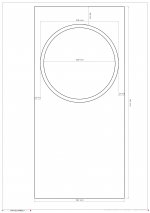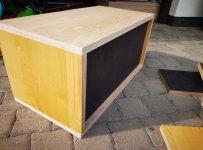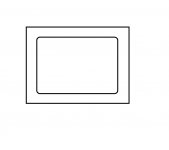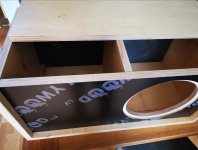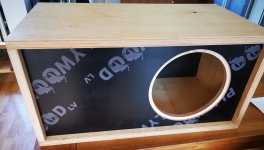Member
Joined 2009
Paid Member
When I say modern take on it I mean something useful for home use whereas the original was probably designed for clarity of voice in a large room - I don’t think I’d enjoy the original, it will be too bright
VoTT requires a rising on axis response driver like a guitar driver: http://www.lansingheritage.org/images/altec/specs/components/421a/page2.jpg
GM
edit: Even better, response wise, though not spec wise for the reflex part of the cab: https://www.eminence.com/pdf/Legend_BP1525.pdf
When I say modern take on it I mean something useful for home use whereas the original was probably designed for clarity of voice in a large room - I don’t think I’d enjoy the original, it will be too bright
The original isn't 'bright' other than much more efficient/'focused' in the ~200-1 kHz BW. 'Sounds' like your version would be a pure conical WG.
GM
VoTT requires a rising on axis response driver like a guitar driver: http://www.lansingheritage.org/images/altec/specs/components/421a/page2.jpg
GM
Haven't given the 421 much thought,
Yet,
It seems it has a flux density in 515 territory ...
Other than only having fractional Xmax, the 421 series is a good match up, so sufficient for typical HIFI/HT apps based on having tested 421-8H in A7-500 cabs, though the 'chrome dome' needs some form of damping to keep it from 'ripping your head off'.
GM
GM
Today I'm gonna receive my pre-cut plywood pieces. Front baffle drawing is attached. Feeling excited! 🙂
I'm looking with great interesting.😎
Should be fine, with a nice tight bottom end. Earthquake inducing infra-sonics won’t be a feature of the bass response but you can’t expect that from 100dB efficient speakers in a “reasonably” sized box. Laws of physics etc 🙂
Steve - did you use any damping with your enclosure?
Sorry because English isn't my first language,do you mean that is a small box?
What size will be your recommendation?
What size will be your recommendation?
Steve - did you use any damping with your enclosure?
Top half above the holey brace - no treatment of any kind.
Bottom half below the brace - inner surfaces lagged with 2” of rockwool type insulation, glued to the cabinet walls.
The internal air space itself, has no wadding whatsoever. It destroys the music completely, making the whole presentation tight and shrieky, which is not what you want with this driver, believe me! 😱
Top half above the holey brace - no treatment of any kind.
Bottom half below the brace - inner surfaces lagged with 2” of rockwool type insulation, glued to the cabinet walls.
The internal air space itself, has no wadding whatsoever. It destroys the music completely, making the whole presentation tight and shrieky, which is not what you want with this driver, believe me! 😱
OK, thank you! Interesting that you damped only the bottom half, is there a technical explanation for that or is it just years of experience? Also why the brace with holes, does it somehow work better compared to fully "open" brace (I added a sketch)? Is there a difference in sound? Open brace should be quite similar strength wise if thick enough ply is used.
thimios - my enclosure is 100L, Steve made it 80L. What I've read from Steve's posts, this is the optimum size for sealed 12-250TC.
Attachments
Ok,thanks for your answer.OK, thank you! Interesting that you damped only the bottom half, is there a technical explanation for that or is it just years of experience? Also why the brace with holes, does it somehow work better compared to fully "open" brace (I added a sketch)? Is there a difference in sound? Open brace should be quite similar strength wise if thick enough ply is used.
thimios - my enclosure is 100L, Steve made it 80L. What I've read from Steve's posts, this is the optimum size for sealed 12-250TC.
Please let me know what is the plywood thickness that you using?
Front and rear wall are 28 mm, the rest is 24 mm. But that's only because I got those plywood pieces cheap. 24 mm for the whole cabinet is enough I assume, it will make it crazy heavy anyway 🙂
OK, thank you! Interesting that you damped only the bottom half, is there a technical explanation for that or is it just years of experience? Also why the brace with holes, does it somehow work better compared to fully "open" brace (I added a sketch)? Is there a difference in sound?...
It was experience and a bit of empirical “listen to the effects” stuff.
I used to build sealed box speakers back in the 70s, and built several, with big paper cone drivers, for my engineering science A Level course, back in 1976. I learned that Q only really matters if it goes above 1 and that loads of damping kills the music. I’ve since built a few more and despite the fashion for ports, sealed box bass is still for me, the best there is; not the deepest in town for the box size, especially with high efficiency drivers but it just sounds “right” to me.
The brace doesn’t have to be holey, but I’ve found over years of building speakers, that it is more effective at connecting opposite walls of the cab together, hence slightly better rigidity than an open brace. But if you’re using 24mm ply, I can’t see rigidity being a major issue anyway.
Last edited:
- Home
- Loudspeakers
- Full Range
- Fane 12-250TC or 15-300TC in a large sealed enclosure
